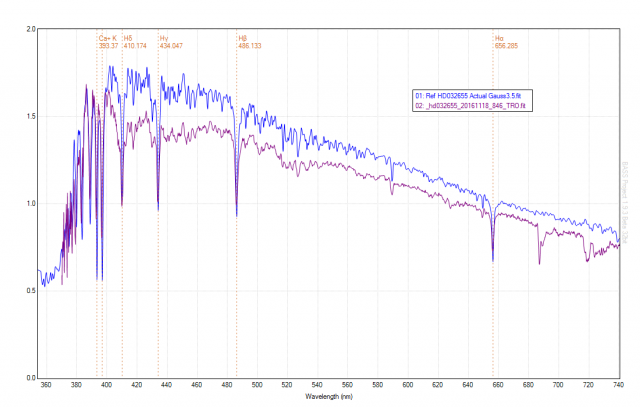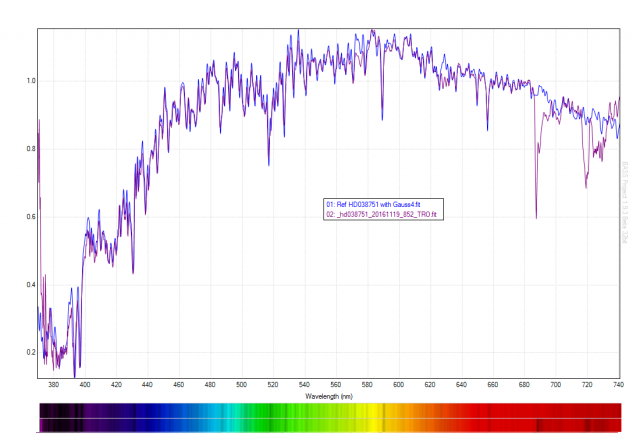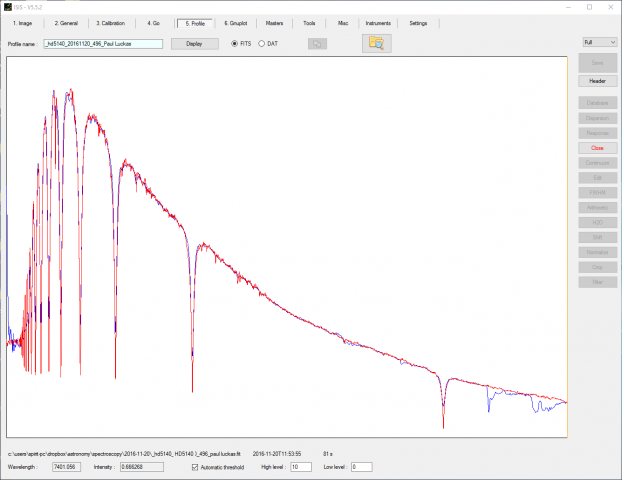› Forums › Spectroscopy › My tea is cold – again.
- This topic has 8 replies, 3 voices, and was last updated 9 years ago by
 Robin Leadbeater.
Robin Leadbeater.
-
AuthorPosts
-
22 November 2016 at 5:07 pm #573637
 Tony RoddaParticipant
Tony RoddaParticipantHi Folks,
This is somewhat absorbing isn’t it… Processing ALPY600 spectra and the whole learning process I mean.
Following Robin’s lead I’ve been chasing Miles stars for comparison. See below. Not my best attempt (not long enough exposures nor enough of them) but I was intrigued by the process.
This one has a touch too much blue extinction and the camera has a ‘big blue hump’ of its own but I’m heartened by the general form and the remarkable similarity in the features. (I’ve applied a Gaussian 3.5 filter to the Miles reference spectra and offset the plots for easier reading). I need to refine my atmos extension and ref curve production. So technique is lacking somewhat.
I’ve got another half dozen to process plus RX And (in outburst) and V0725 Tau spectra to play before a clear night forecast tomorrow. I’ll post asap.
I’ve also completed my first run-through for calibrating the flux and photometric extraction. Got there in the end but not very fluent. Amazing what you can do with this little machine and the software – and we’re just scratching the surface.

PS – I’ve formatted an Astroplanner observing schedule for all the Miles stars if anyone is using that s/w.
Regards
Tony
Attachments:
22 November 2016 at 9:26 pm #577671 Tony RoddaParticipant
Tony RoddaParticipantAnother Miles star this time with better exposures…
 23 November 2016 at 1:53 am #577673
23 November 2016 at 1:53 am #577673 Robin LeadbeaterParticipant
Robin LeadbeaterParticipantLooking good, Tony
I can see a couple of interesting places where the two are slightly different at ~5750 and ~6300. I wonder if the differences are real? There is a telluric O2 band at 6277A but nothing as far as I know at 5750. Christian Buil has an annotated Vega spectrum here which shows the Tellurics.
http://www.astrosurf.com/buil/us/vatlas/vatlas.htm.
If you divide your measured by the filtered library it will show up very clearly any discrepancies. It is particularly worth doing with the reference star itself which should of course match perfectly. You can use any differences to see where you might need retune your response calculation.
Cheers
Robin
24 November 2016 at 7:45 pm #577676 Tony RoddaParticipant
Tony RoddaParticipantThanks Robin. I’ve been playing around with the instrument response and the ‘art’ of defining the response curve.
I’d spotted the two anomalies you mention but there’s no bump/dip in my curve at those wavelengths so I’m at a loss.
I’ve now tried the division of curves and I get the idea of highlighting the discrepancies but I lack the practiced eye to diagnose the causes.
Onward and upward!
25 November 2016 at 12:33 am #577674 Paul LuckasParticipant
Paul LuckasParticipantHi all,
I’ve been following these posts with some interest, having performed similar tests over the past couple of years while coming to terms with with the ‘black art’ of instrument response correction with both the Alpy and Lhires spectrographs. Most recently (during a spate of bad weather) I’ve been playing around with the response assistant in ISIS. I don’t think the response assistant was developed as a serious replacement for the more rigorous method (as far as I can tell, it can’t correct for atmospheric attenuation) but I’ve been achieving some interesting and remarkably good results despite that, which I’m still trying to get to the bottom of.
The attached profile is a spectrum of HD4150, corrected using the response assistant (blue), with the Miles standard HD31295 and a high quality master flat as the input. The comparison with the Miles standard (red) shows excellent correlation.
A short draft report on the process and some early findings can be found here if of any interest:
http://jazzistentialism.com/blog/wp-content/uploads/2016/11/correcting-instrument-response.pdf

Best wishes,
Paul
25 November 2016 at 3:18 pm #577677 Robin LeadbeaterParticipant
Robin LeadbeaterParticipantHi Paul,
That looks interesting
I have not used this before but cannot find a description of exactly what it does on Christian’s website (It is not mentioned in his ISIS change log for example where I normally look). I had assumed it just automated the usual “differential spectroscopy” procedure, using the “response” and “continuum” functions under the profile tab to calculate the response using a reference star at a particular air mass which is then used with the target star spectrum at similar air mass. Does it do something different to this?
EDIT:- rereading your paper, am I correct in saying that the response assistant calculates the response using only the flat and the reference spectrum? ie you do not need to measure the reference star?
Cheers
Robin
26 November 2016 at 2:29 am #577679 Paul LuckasParticipant
Paul LuckasParticipantHi Robin,
Yes, as far as I can tell the algorithm uses only a master flat and a database reference to create a ‘synthentic’ instrument response profile, which is why I’m at a loss to explain why the results (including those of several cooler stars that I haven’t published) are as good as they are, given that there is presumably no atmospheric correction applied.
The automated smoothing becomes less reliable beyond type-B and type-A stars which may also limit its use. Despite that, it does appear to be yet another cool little feature in ISIS.
Regards,
Paul
26 November 2016 at 10:56 am #577680 Robin LeadbeaterParticipant
Robin LeadbeaterParticipantHi Paul,
I am at a loss to know what it is doing. It could perhaps be using the flat lamp as a reference assuming a nominal black body spectrum for the flat lamp including allowance for typical atmospheric extinction, but then why would it need the reference star library spectrum at all, and what is it comparing the library spectrum against ? It does seem to work though. I shall have a play, but I am not sure I would ever fully trust it !
26 November 2016 at 11:24 am #577681 Robin LeadbeaterParticipant
Robin LeadbeaterParticipantOK I found a description of using the response assistant here in the LISA tutorial (about half way down)
http://www.astrosurf.com/buil/isis/guide_lisa/tuto_en.htm
it appears it reruns the reduction of whatever spectrum data is currently set up in ISIS, but without a flat correction.(This is all hidden in the background) It then combines this with the flat and the reference spectrum (which has to be of the same object which ISIS has reduced in the background) to produce the instrument response. This is effectively the same as the usual “long hand” way of doing an instrument response but with some automation. It does seem a slightly confusing way of going about though. All very odd !
Cheers
Robin
-
AuthorPosts
- You must be logged in to reply to this topic.
